It is impossible to carry a rifle without food. The Warsaw insurgents knew it very well. Soup-spit, porridge with worms, workhorses on a plate. In August 1944, the fight against hunger was not much easier than the fight against the occupant.
The beginnings did not foreshadow a catastrophe. In the first days of the fighting, the participants of the uprising did not have to worry about food. Before the "W" hour, ackowcy and people associated with the underground began scrupulously gathering food. With the great help of landowners near Warsaw and various private individuals, they stored sacks of coffee, tea, sugar, potatoes, cabbage, melted fat and other equally basic and necessary items. 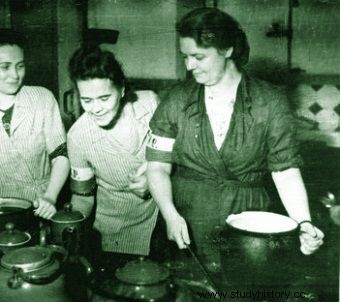
Powstanka, Halina Regulska, who worked in a soldier's kitchen during the fights, recalled that around 2 p.m. the front canteen was full . The young soldiers came in good spirits and joked about.
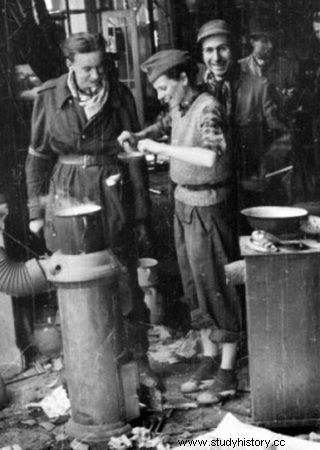
A well-fed insurgent is a smiling insurgent.
We waited for them to have dinner ready. Armed with bowls, spoons and a ladle, we poured the soup. I was careful to pour fair portions and put three pieces of meat in each bowl. They - hungry - followed the movement of my hand with their eyes. They sat wherever they fell, on benches, on tables, on the floor. They liked the soup very much.
Regulska called her canteen an inn. And in that inn, together with other ladies in uniform, she cooked soup in cauldrons for three hundred insurgents. The "boys" were running straight from the front line to fill their gurgling bellies.
The soup was great for the first two weeks and fully satisfied young appetites . Later it became more and more difficult to obtain supplies. At the beginning of the uprising, however, the inn's staff had something to cook. The women were making mashed potatoes, cutting up the horse and boiling the beans . This made meaty soup.
Horse. A multifunctional creation
Some people may flinch at the thought of eating horse meat, but the reality of the occupation and the uprising left no room for sentiment. Initially, the horse was used as a draft animal in the city. Pulling a cart, he transported the wounded to the hospital around Warsaw, or potatoes heroically dug up by the insurgents under enemy fire.
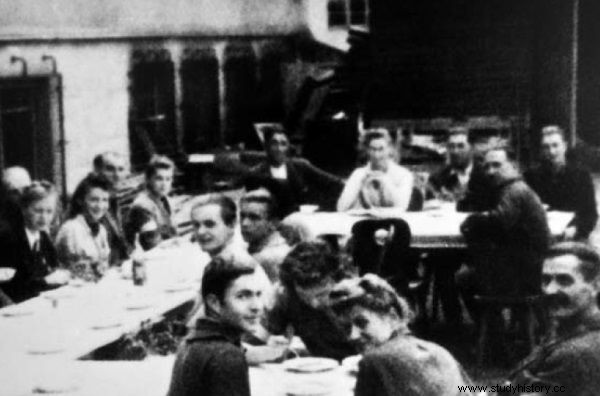
On August 15, 1944, there was still enough food to eat. Insurgents from the "Żywiciel" group are sitting at a set table in the "Poniatówka" gymnasium in Żoliborz.
Fortunately, the insurgents with the horse did not go out of town for vegetables. They didn't have to. During the war, all of Warsaw was dotted with allotment gardens that fed the capital's inhabitants . Fortunately, the period of the uprising is also the time of harvest, so these small plantations saved many insurgents from hunger.
The horse, transporting the supplies gathered with difficulty, could not hide under the cover of walls, cellars and recesses. At one point he was hit by a bullet of a "pigeon fancier" (sniper) crouching on the roof. In the absence of alternatives, even after his death, the horse served the unit. Under the cover of night, they took it from the street and ate it.
Slowly and the horses were running out. Regulska recalls that in mid-August the inn began to experience shortages in supplies, which only deepened with time. The soup given to the insurgents became less and less meaty. First the meat ended, then the next fillers. In the end, the cooks only have groats left.
Hunger looked into the eyes of more and more people. Dog owners guarded their pets with redoubled vigilance knowing that for hungry neighbors their poodle or bulldog is starting to be nothing more than material for a cutlet.
Because the rubble in the pot and God bless you ...
Sometimes it happened that the canteen was not able to spend dinner at all on a given day. The cooks did what they could. Unfortunately, they could by no means overcome one particular obstacle - artillery fire. When the Germans were shooting somewhere close, everything collapsed, burned and rained on the head, and consequently into the pot with soup.
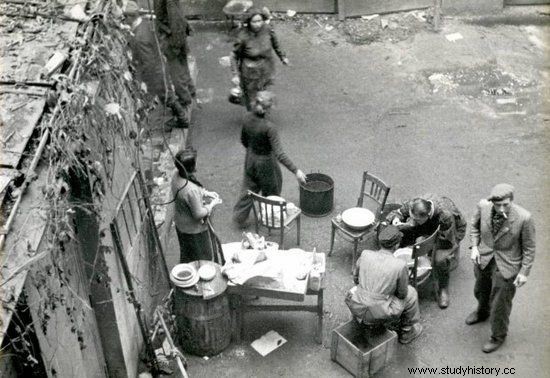
Any place was good to eat.
Cooks often started their work several times. Pour out the contents of the boiler, rinse and throw away the debris, light a fire, put a pot on it, fill it with water and cook again ...
Hunger also affected the soldiers. One of the main characters of the book "Girls from the Uprising" by Anna Herbich describes what it looked like in practice after a few weeks of fighting:
We ate from case to case. When we occupied apartments and houses, we often found some supplies there. So usually half and half porridge with worms, sometimes rusks, in exceptional cases canned food. I remember that happiness smiled at me once and found a bottle of melted butter.
This article has more than one page. Please select another one below to continue reading.Attention! You are not on the first page of the article. If you want to read from the beginning click here.
Sometimes the insurgents managed to get some bigger supplies. When they fought in Mokotów, they found an entire German tomato puree warehouse.
Not taking advantage of such a chance (especially as the population of the capital was suffering from a lack of vitamins, apart from hunger), would be a huge waste.
We had a cook, John, who had the nickname "Kundys". In order to diversify the menu, he cooked alternately:either tomato soup with pasta or pasta with tomato sauce.
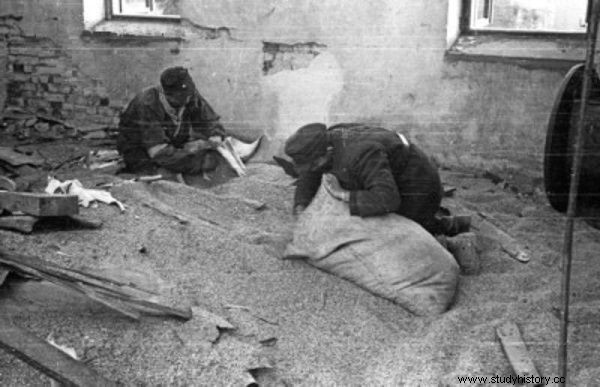
Insurgents taking barley from Haberbusch's brewery.
In addition, while they were still there, we had some rusks for dinner. […] The tomatoes ran out quickly and there was nothing to eat. (quoted after:A. Herbich, "Girls from the Uprising").
Soup-spit
In Powiśle, the grain warehouses were seized, from which the insurgents took the uncleaned grain in bags. They used it to make soup, which was called spit soup.
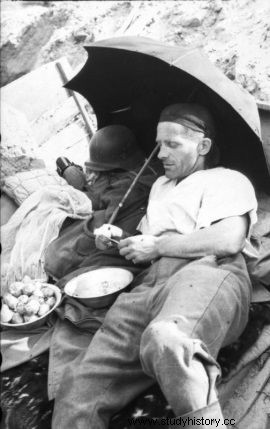
The enemy also had to eat. German soldier in the Warsaw Uprising.
This probably the most famous dish of the insurgents took its name from the fact that it forced them to spit, which must have been especially remembered by young people from good homes.
In any case, soup-spit appears in many insurgent memories and is associated with various places on the map of Warsaw. Among them, a prominent place is occupied by barley warehouses supplying the Haberbusch Brewery. Insurgent Jerzy Radzikowski recalls:
As for those "Zawiszaks" who stayed with me at 28 Mokotowska Street, where there was a large scout hostel, the food there was the so-called spit-spit soup . It was a soup made of overcooked barley. So it was awesome what to say
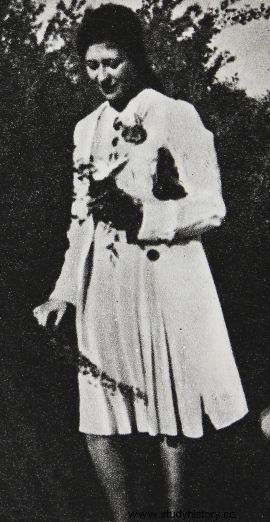
Most often we found groats with worms - says Rena Wołłowicz in the book "Girls from the Uprising".
Stanisław Leon Luft also remembered the famous soup:
It was very hard! Officially, you would get such a soup once a day - we called it "spit-soup". "Spit-soup" because it was made of unshelled grain, so that the chaff had to be spit out all the time ... someone… very accidentally.
And how to live? How to fight? It was getting worse and worse with each passing day. Jerzy Borowski summed it up briefly and in a soldier manner.
But what exactly did we eat? We didn't get any food at all, we went hungry like dogs.
The Warsaw Uprising is not only blood, sweat, tears and death. For the young soldiers it was also one great and overwhelming hunger, which slowly quenched their strength and hope.
Bibliography:
- A. Herbich, Girls from the Uprising , Znak Horyzont, Krakow 2014.
- H. Regulska, Those Years, Those Times , National Institute for them. Ossoliński, Wrocław 1988.
- Archive of Oral History of the Ministry of National Defense, testimony of the insurgent Jerzy Borowski [accessed May 15, 2014].
- Archive of Oral History of the MPW, testimony of an insurgent Stanisław Leon Luft [accessed May 15, 2014].
- Archive of Oral History of the MPW, testimony of an insurgent Jerzy Radzikowski [accessed May 15, 2014].
